47 Tucanae is a bright globular cluster located 14,500 light-years away in the southern constellation Tucana. With an apparent magnitude of 4.09, the cluster is visible to the unaided eye on a clear night. It is the second brightest globular cluster in the sky, after Omega Centauri in the constellation Centaurus. 47 Tucanae is catalogued as NGC 104 in the New General Catalogue and as Caldwell 106 in Sir Patrick Moore’s Caldwell catalogue of deep sky objects visible in amateur telescopes.
47 Tucanae has a diameter of 120 light-years and an apparent size of 43.8 arcminutes, comparable to the size of the full Moon in good conditions. The cluster appears next to the Small Magellanic Cloud (SMC), a satellite galaxy of the Milky Way. Even though they appear close in the sky, the cluster is over 15 times closer to us than the dwarf galaxy and the two are not physically related.
NGC 104 contains millions of stars and is one of the most massive globular clusters in the Milky Way. It has an estimated mass of 700,000 Suns. The most massive stars lie in the cluster’s small, dense, bright core.
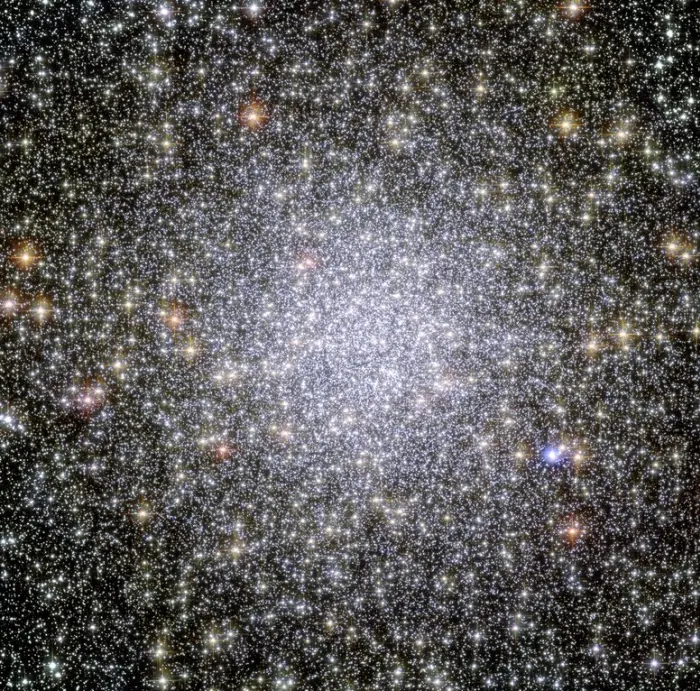
This NASA/ESA Hubble Space Telescope image shows a globular cluster known as NGC 104 — or, more commonly, 47 Tucanae, since it is part of the constellation of Tucana (The Toucan) in the southern sky. Image credit: NASA, ESA, and the Hubble Heritage (STScI/AURA)-ESA/Hubble Collaboration Acknowledgment: J. Mack (STScI) and G. Piotto (University of Padova, Italy) (CC BY 2.0 DEED)
The cluster has the Shapley-Sawyer Concentration Class III, indicating a strong inner core of stars. Telescopes resolve about 10,000 stars in the cluster. Many of these stars are in the cluster’s centre.
The brightest star in 47 Tucanae is commonly referred to as the “Bright Star.” It is a hot blue giant of the spectral type B8III that has evolved past the asymptotic giant branch phase. The star has an effective temperature of 10,850 K and a luminosity 1,100 times that of the Sun. Like other post-AGB stars, it has lost a lot of its mass through a strong stellar wind and now has a mass about 54% that of the Sun.
47 Tucanae hosts at least two populations of stars with different metallicities and ages. Like other massive globular clusters, it contains a complex stellar population. The cluster’s core is home to a number of exotic stars, including blue stragglers. These are stars that are hotter, bluer, more massive and more luminous than expected for their evolutionary stage. They are believed to be the products of interactions and collisions between two or more stars in a tightly packed environment.
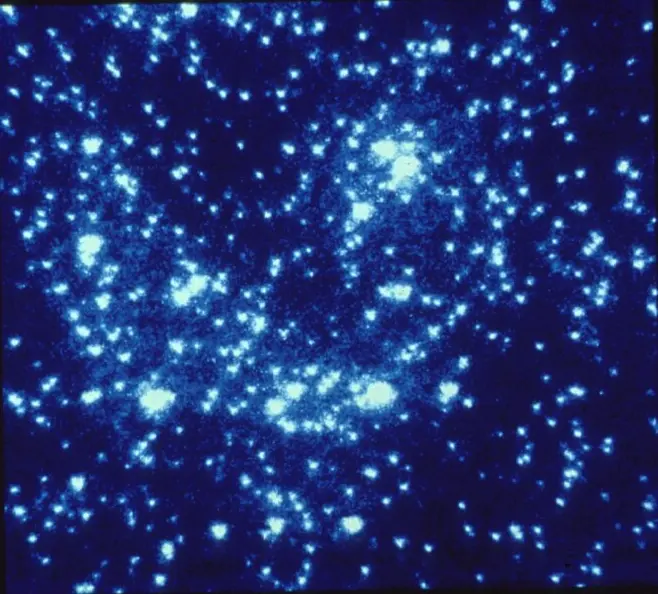
The core of the globular cluster 47 Tucanae, as imaged by the European Space Agency’s Faint Object Camera (FOC) onboard NASA’s Hubble Space Telescope. Space Telescope’s high spatial resolution and ultraviolet sensitivity make it a powerful tool for probing the centers of globular clusters. The FOC resolves several hundred stars where ground-based images only yield a few dozen stars. At least 21 of these stars are exceptionally bright in ultraviolet light. HST’s UV sensitivity and high resolution allow it to easily separate these so-called blue stragglers stars from the red giant stars which dominate the cluster. Blue stragglers may evolve from “old age” back to a hotter and brighter youth through stellar collisions and mergers. This high concentration of blue stragglers towards the core of 47 Tucanae suggests they are significantly more massive than most of the cluster’s stars. Some of blue stragglers could be massive because they are really double star systems. Such binary systems may influence the motions of thousands of other stars within the cluster. The FOC observations were made in ultraviolet light (2200 angstroms) on November 16, 1990 with the FOC in F/96 mode. Field of view is 11 X 11 arc seconds corresponding to a width of .75 light years, at 47 Tucanae’s distance of 15,000 light years. Image credit: Francesco Paresce (ESA/STScI). Michael Shara (STScI), Georges Meylan (ESA/STScI), NASA/ESA
The cluster is also home to low-mass X-ray binaries containing neutron stars, black widow pulsars, and accreting white dwarfs. A 2021 study identified candidate symbiotic stars and RS CVn contact binaries.
In 2015, observations with NASA’s Chandra X-ray Observatory, the NuSTAR telescope and the Australia Telescope Compact Array revealed a star in the closest orbit known around a black hole. Designated 47 Tucanae X9, the system is composed of a black hole that is pulling gas from a white dwarf. The white dwarf orbits the black hole with a period of only 28 minutes at a separation of about 2.5 times the distance between the Earth and the Moon.
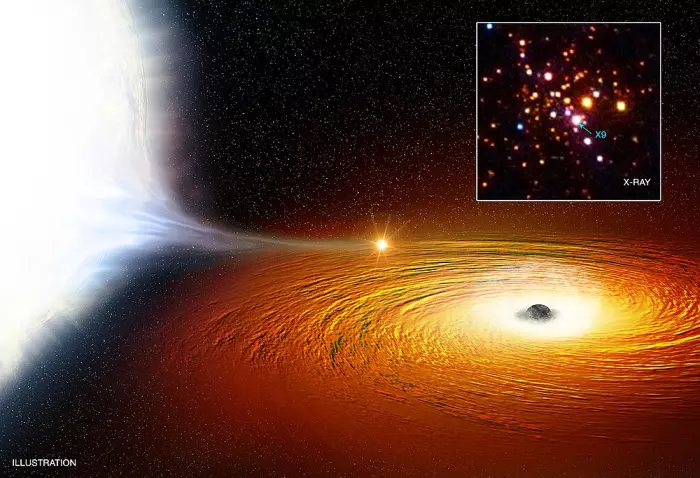
This graphic features an artist’s impression of a star found in the closest orbit known around a black hole. This discovery was made using data from NASA’s Chandra X-ray Observatory (shown in the inset where low, medium, and high-energy X-rays are colored red, green, and blue respectively), plus NASA’s NuSTAR telescope and the Australia Telescope Compact Array. Astronomers found this extraordinarily close stellar pairing in the globular cluster named 47 Tucanae, a dense collection of stars located on the outskirts of the Milky Way galaxy, about 14,800 light years from Earth. This particular source, known as X9, has been of interest to scientists for many years. Until a couple of years ago, astronomers thought X9 contained a white dwarf pulling material from a companion star like the Sun. (Astronomers call a pair of objects orbiting one another a ‘binary’ system.) However, a team of scientists in 2015 used radio data to show that X9 likely consisted instead of a black hole pulling gas from a white dwarf companion. These researchers predicted that the white dwarf would take only about 25 minutes to orbit the black hole. New Chandra data likely verify this hypothesis and reveal that the X-rays change periodically over about 28 minutes. Additionally, Chandra data show evidence for large amounts of oxygen in the system, a characteristic for the presence of a white dwarf. Therefore, a strong case can be made that that the companion star is a white dwarf, which would then be orbiting the black hole at only about 2.5 times the separation between the Earth and the Moon. Image credit – X-ray: NASA/CXC/University of Alberta/A.Bahramian et al.; Illustration: NASA/CXC/M.Weiss
NGC 104 contains at least 25 millisecond pulsars. X-ray emission from 19 of these pulsars was detected by the Chandra X-ray Observatory in 2006. The radiation is believed to originate from the pulsars’ heated polar caps.
These stellar remnants were likely part of X-ray binary systems and accreted material from their companions. One of these companions, designated 47 Tucanae W, appears to still be transferring material onto its companion neutron star. This indicates that the system is evolving from a low-mass X-ray binary to a millisecond pulsar. The neutron star’s spin rate was increased by the mass transfer from the companion star.
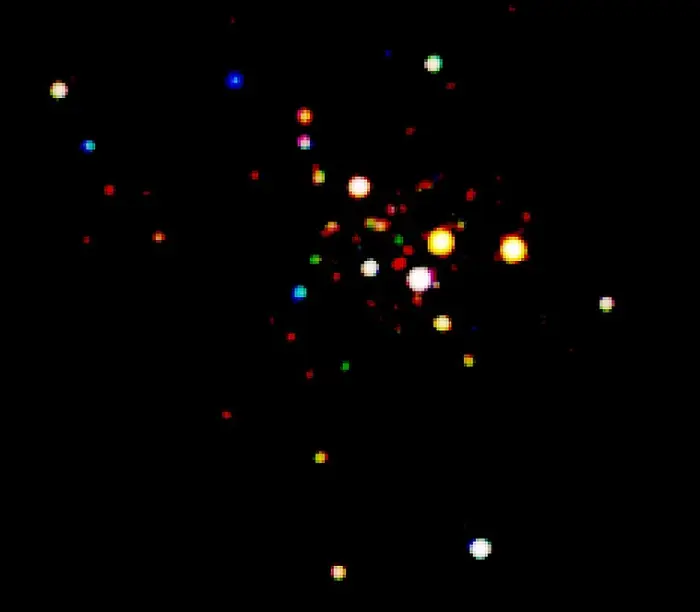
This Chandra image provides the first complete census of compact binary stars in the core of the globular cluster known as 47 Tucanae. As the oldest stellar systems in the Milky Way Galaxy, globular clusters are laboratories for stellar and dynamical evolution. Nearly all objects in the Chandra images are “binary systems,” in which a normal, Sun-like star companion orbits a collapsed star, either a white dwarf or neutron star. The data also reveal the presence of “millisecond pulsars” that rotate extremely rapidly, between 100 to nearly 1000 times a second. Image credit: NASA/CfA/J.Grindlay et al., Smithsonian Institution
47 Tucanae was the first globular cluster to be detected in gamma-rays. The gamma-ray emission from the cluster was detected by the Fermi Gamma-ray Space Telescope in 2009. It originates from the millisecond pulsars in the cluster. The gamma rays were believed to be produced in the outer magnetosphere of the neutron stars.
In dense clusters like 47 Tucanae, heavier members tend to move towards the centre while the less massive ones move toward the outskirts. The process is known as mass segregation. The first evidence of mass segregation in the cluster was reported in 2015, when a team led by Jeremy Heyl of the University of British Columbia (UBC), Vancouver, captured white dwarfs in the process of moving outward. The observations were made with NASA’s Hubble Space Telescope.
The cluster may host an intermediate-mass black hole in its centre. However, the existence of the black hole is uncertain. Data obtained with the Hubble Space Telescope in 2006 allowed astronomers to study the radial velocities of stars in the cluster’s core and constrain the mass of any central black hole to 1,000 – 1,500 solar masses.
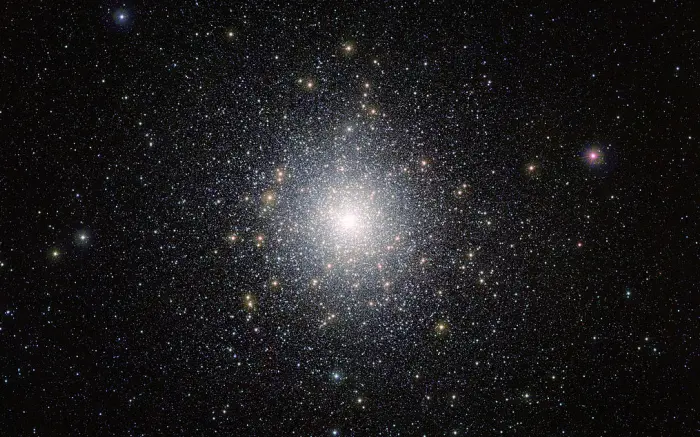
This new infrared image from ESO’s VISTA telescope shows the globular cluster 47 Tucanae in striking detail. This cluster contains millions of stars, and there are many nestled at its core that are exotic and display unusual properties. This image is very sharp and deep due to the size, sensitivity, and location of VISTA, which is sited at ESO’s Paranal Observatory in Chile. In amongst the swirling mass of stars at the cluster’s heart lie many intriguing systems, including X-ray sources, variable stars, vampire stars, unexpectedly bright “normal” stars known as blue stragglers, and tiny objects known as millisecond pulsars, small stellar remnants that rotate astonishingly quickly. Red giants, stars that have exhausted the fuel in their cores and swollen in size, are scattered across this VISTA image and are easy to pick out, glowing a deep amber against the bright white-yellow background stars. The densely packed core is contrasted against the more sparse outer regions of the cluster, and in the background huge numbers of stars in the Small Magellanic Cloud are visible. This image was taken using ESO’s VISTA (Visible and Infrared Survey Telescope for Astronomy) as part of the VMC survey of the region of the Magellanic Clouds, two of the closest known galaxies to us. Image credit: ESO/M.-R. Cioni/VISTA Magellanic Cloud survey; acknowledgment: Cambridge Astronomical Survey Unit (CC BY 4.0 DEED)
A 2017 study led by Bülent Kızıltan and Abraham Loeb of the Harvard-Smithsonian Center for Astrophysics, Cambridge, MA, and Holger Baumgardt of the University of Queensland, Brisbane, Australia, provided evidence for the existence of a gas-starved black hole that was not accreting at a sufficient rate. Based on the distribution and motions of the pulsars in NGC 104, the researchers estimated that the black hole has a mass of about 2,300 solar masses. The study was published in the journal Nature. However, later long-term observations of the pulsars in the cluster yielded no evidence of a black hole.
47 Tucanae was the target of a survey for planets, conducted using the Hubble Space Telescope (HST) in 2000. The survey was conducted by an international team of astronomers led by Ronald Gilliland of the Space Telescope Science Institute (STScI) in Baltimore, Maryland.
Even though astronomers expected to find 10-15 planets in the cluster’s core, they detected none, which suggests that planets are not as common in globular clusters as previously believed. A survey of the less crowded outer regions of 47 Tucanae did not find any planets either, which indicates that the crowding in the cluster’s core is not as responsible for the absence of planets as the low metallicity of the cluster.
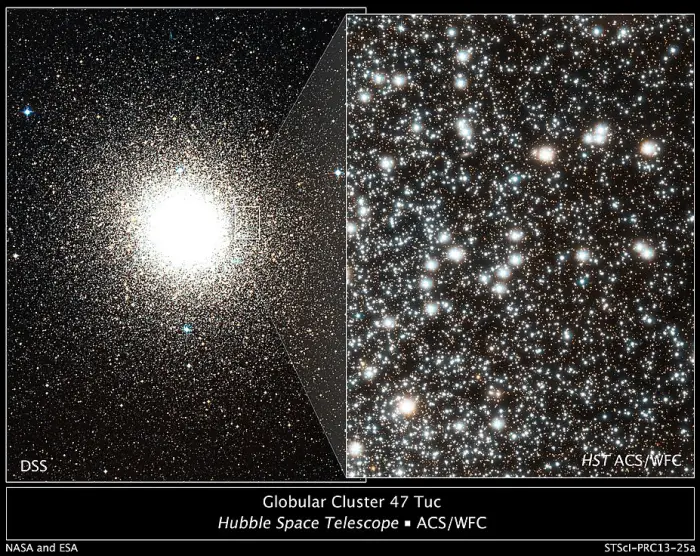
These images showcase the ancient globular cluster 47 Tucanae, a dense swarm of up to a million stars.
The image on the left shows the entire cluster, which measures about 120 light-years across. Located in the southern constellation Tucana (The Toucan), the cluster is about 16700 light-years away. The image is part of the Digitized Sky Survey (DSS) and was taken by the UK Schmidt Telescope at Siding Spring Observatory in New South Wales, Australia. The white rectangular box outlines the view taken by the NASA/ESA Hubble Space Telescope. That image, shown at right, captures close-up views of thousands of cluster stars. The large bright stars in the image are red giants. These stars have puffed up to several times their normal size because they have exhausted their nuclear fuel and are near the end of their lives. The image was taken by Hubble’s Advanced Camera for Surveys. Astronomers used these Hubble observations along with archival Hubble data of 47 Tucanae to accurately measure the changes in positions of more than 30 000 cluster stars. Based on those measurements, the astronomers pieced together the stars’ histories, finding two populations of stars that have different chemical compositions and different motions. Understanding the dynamics of the 47 Tucanae stars can yield insights into how this cluster formed its stars. The Hubble image was taken between January and October 2010. The Schmidt telescope image was taken Oct. 12, 1977, and Sept. 9, 1989. Image credit: NASA, ESA, Digitized Sky Survey (DSS; STcI/AURA/UKSTU/AAO), H. Richer and J. Heyl (University of British Columbia), and J. Anderson and J. Kalirai (STScI)
Facts
47 Tucanae has a similar apparent size to Omega Centauri. At its longest extension, it stretches across 43.8 arcminutes, while Omega Centauri has apparent dimensions of 36.3 arcminutes across. Omega Centauri lies further away, at a distance of 15,800 light-years from the solar system. It is much more loosely concentrated towards the centre and has the concentration class VIII. With an apparent magnitude of 3.9, it is the brightest globular cluster in the sky.
The third and fourth brightest globular clusters, the Sagittarius Cluster (Messier 22) in the constellation Sagittarius and the Great Peacock Globular (NGC 6752) in Pavo are smaller and a full magnitude fainter. M22 has an apparent magnitude of 5.1 and an apparent size of 32 arcminutes, while NGC 6752 shines at magnitude 5.4 and occupies 20.4 arcminutes. All four clusters lie in the southern sky and are easier to observe from the southern hemisphere.
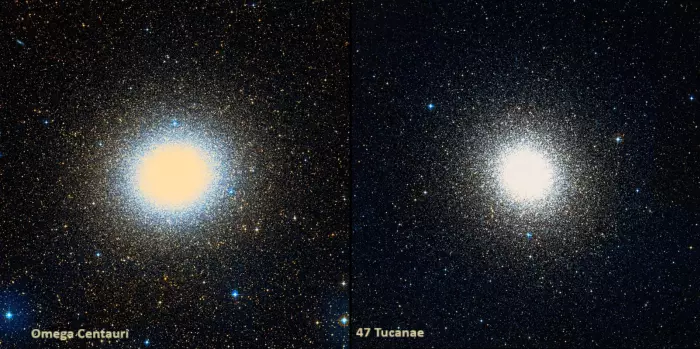
Omega Centauri and 47 Tucanae comparison. The field of view is one degree. Image: Wikisky (DSS)
Despite its brightness and size, 47 Tucanae is largely unfamiliar to northern observers. It only appears low above the horizon from northern locations that are closest to the equator.
47 Tucanae was not known to European astronomers before the 1750s, when French astronomer Nicolas-Louis de Lacaille spotted it from South Africa.
Lacaille spent four years (1750 – 1754) studying the southern sky from the Cape of Good Hope and is credited for creating 14 southern constellations. Tucana was not one of them. (It was created by Dutch astronomer Petrus Plancius in the late 16th century based on observations of Dutch explorers Pieter Dirkszoon Keyser and Frederick de Houtman.) However, when he created the new constellations, Lacaille reorganized this part of the southern sky, transferring 47 Tucanae and a part of the Small Magellanic Cloud to Tucana. The cluster and the galaxy had previously been assigned to the constellation Hydrus.
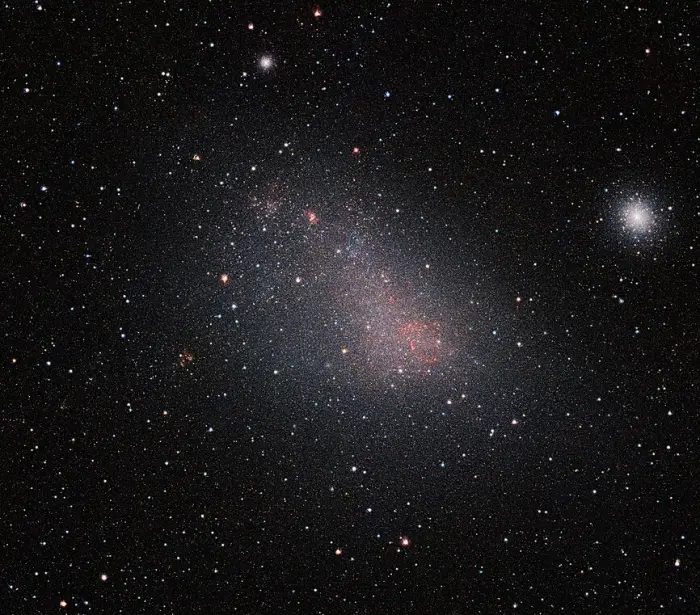
The Small Magellanic Cloud (SMC) galaxy is a striking feature of the southern sky even to the unaided eye. But visible-light telescopes cannot get a really clear view of what is in the galaxy because of obscuring clouds of interstellar dust. VISTA’s infrared capabilities have now allowed astronomers to see the myriad of stars in this neighbouring galaxy much more clearly than ever before. The result is this record-breaking image — the biggest infrared image ever taken of the Small Magellanic Cloud — with the whole frame filled with millions of stars. As well as the SMC itself this very wide-field image reveals many background galaxies and several star clusters, including the very bright 47 Tucanae globular cluster at the right of the picture. Image credit: ESO/VISTA VMC (CC BY 4.0 DEED)
Lacaille observed the cluster in 1751-1752 and initially believed it was the nucleus of a comet. He catalogued it as Lac I-1 in his catalogue of deep sky objects, labelling it as “neb.”
Both 47 Tucanae and the brighter Omega Centauri have stellar designations. While Omega Centauri was given the Bayer designation by Johann Bayer himself based on Ptolemy’s description of the cluster as a star on the centaur’s back, 47 Tucanae was not assigned to the cluster by John Flamsteed (the English astronomer who assigned numbers to stars visible from southern England). The number “47” first appeared in German astronomer Johann Elert Bode’s Allgemeine Beschreibung und Nachweisung der Gestirne nebst Verzeichniss (“General description and verification of the stars and indexes”), published in 1801.
American astronomer Benjamin Apthorp Gould, creator of The Astronomical Journal, designated the cluster ξ Tucanae (Xi Tucanae), but the designation was not widely adopted. The cluster is still commonly referred to as 47 Tucanae.
In December 2008, Australian astronomer Ragbir Bhathal of the University of Western Sydney reported the detection of a strong laser-like signal emanating from 47 Tucanae as part of the Australian Optical SETI Project. However, subsequent searches in the same area did not find the signal again.
Location
47 Tucanae is located in the constellation Tucana (the Toucan). It lies in the far southern sky and stays below the horizon for most observers in the northern hemisphere. At declination -72°, it is only 18 degrees from the south celestial pole and can only be seen from locations south of the latitude 18° N.
The cluster appears next to the Small Magellanic Cloud (SMC) in the sky. The Small Magellanic Cloud is a dwarf galaxy in the Milky Way’s neighbourhood, located approximately 200,000 light-years away. The galaxy is visible to the unaided eye and appears as a faint fuzzy patch on a clear, moonless night. It lies on the imaginary line drawn from Rigil Kentaurus (Alpha Centauri) to Achernar (Alpha Eridani). 47 Tucanae appears only 2.5 degrees west of the SMC.
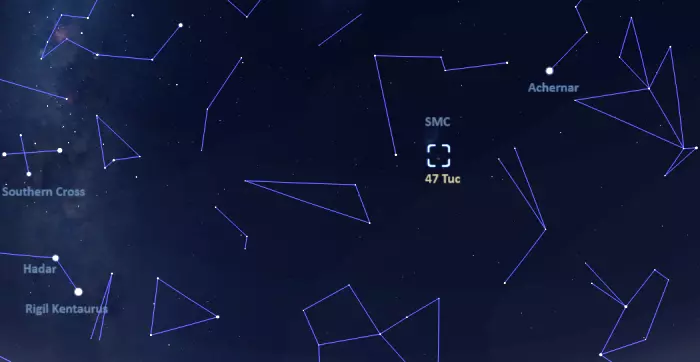
The location of 47 Tucanae and the Small Magellanic Cloud (SMC), image: Stellarium
The best time of the year to observe 47 Tucanae and other deep sky objects in Tucana is during the month of November, when the constellation climbs higher above the horizon in the evening.
47 Tucanae – NGC 104
| Constellation | Tucana |
| Right ascension | 00h 24m 05.359s |
| Declination | −72° 04′ 53.20″ |
| Class | III |
| Apparent magnitude | +4.09 |
| Apparent size | 43.80′ |
| Distance | 14,500 ± 32.6 light-years (4.45 ± 0.01 kiloparsecs) |
| Mass | 700,000 M☉ |
| Radius | 60 light-years |
| Metallicity | -0.78 dex |
| Age | 13.06 billion years |
| Names and designations | 47 Tucanae, 47 Tuc, NGC 104, Caldwell 106, ξ Tucanae, Melotte 1, GCl 1, 1RXS J002404.6-720456 |
Images
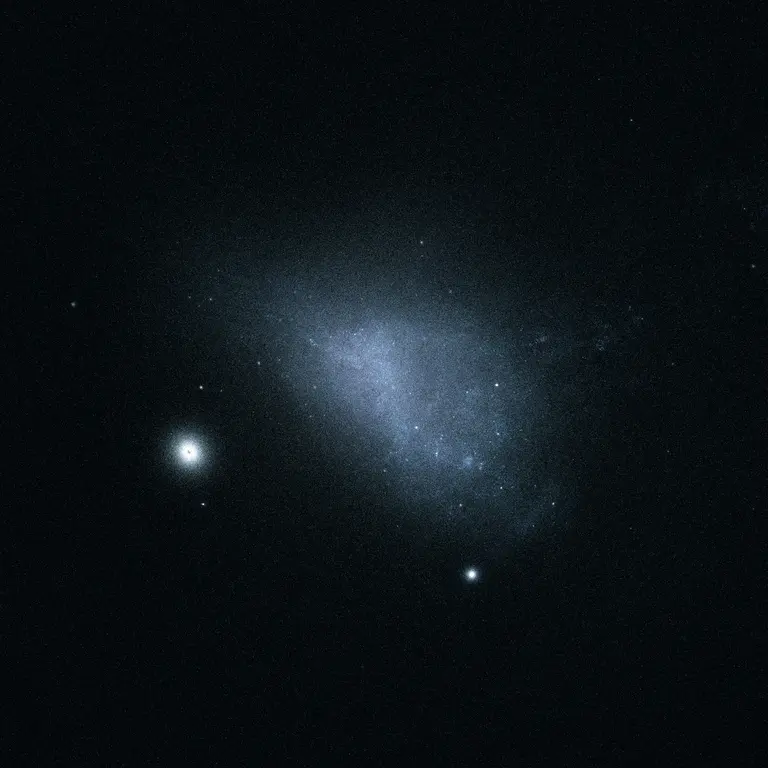
The Small Magellanic Cloud (SMC), one of the nearest galaxies to our Milky Way, as viewed by ESA’s Gaia satellite using information from the mission’s second data release. This view is not a photograph but has been compiled by mapping the total amount of radiation detected by Gaia in each pixel, combined with measurements of the radiation taken through different filters on the spacecraft to generate colour information. To the lower left of the galaxy is the globular cluster 47 Tucanae. The dark pixels at the centre of this cluster are an artefact. They were produced because the density of stars in this region was too high for Gaia to scan and transmit. Image credit: Gaia Data Processing and Analysis Consortium (DPAC); A. Moitinho / A. F. Silva / M. Barros / C. Barata, University of Lisbon, Portugal; H. Savietto, Fork Research, Portugal (CC BY-SA 3.0 IGO DEED)
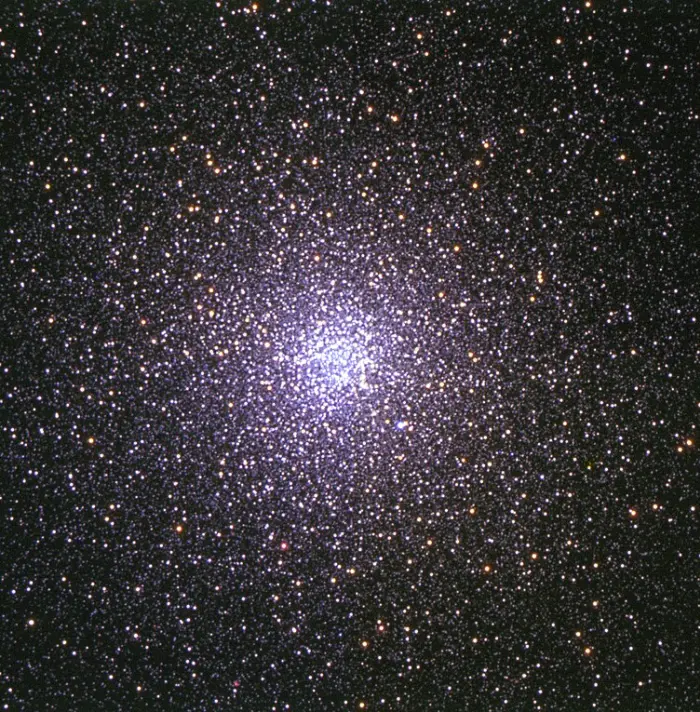
Based on data obtained with FORS1 on Kueyen, UT2 of the Very Large Telescope. The image, 7 arcmin wide, covers the central core of the 30 arcmin large globular cluster. The observations were taken in three different filters: U, R, and a narrow-band filter centred around 485 nm, for a total exposure time of less than 5 minutes. The data were extracted from the ESO Science Archive and processed by Rubina Kotak (ESO) and the final image processing was done by Henri Boffin (ESO). North is up and East is to the left. Image credit: ESO (CC BY 3.0 DEED)
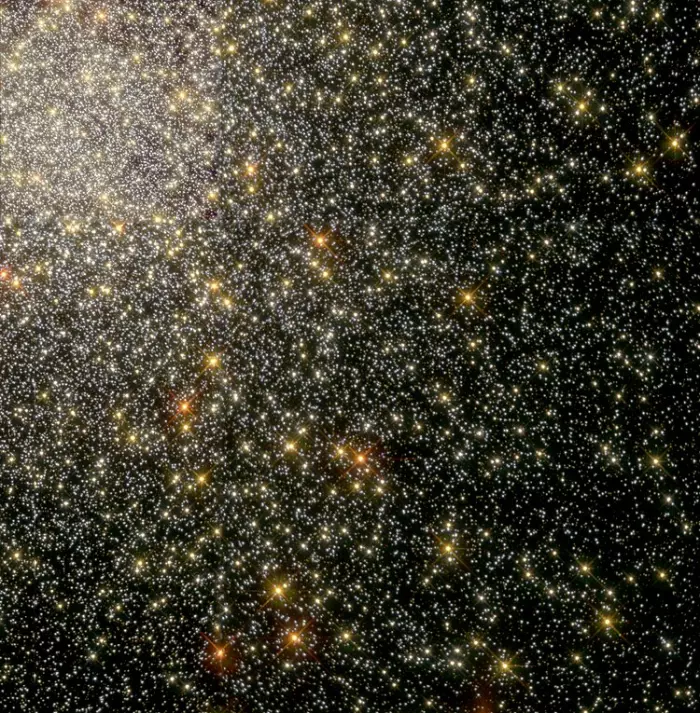
This Hubble image of Caldwell 106 (47 Tucanae), taken in 1999 with the Wide Field and Planetary Camera 2, shows stars packed tightly near the cluster’s core (upper left) and becoming more spread out farther away from the core. Credit: NASA and Ron Gilliland (Space Telescope Science Institute) (CC BY 2.0 DEED)
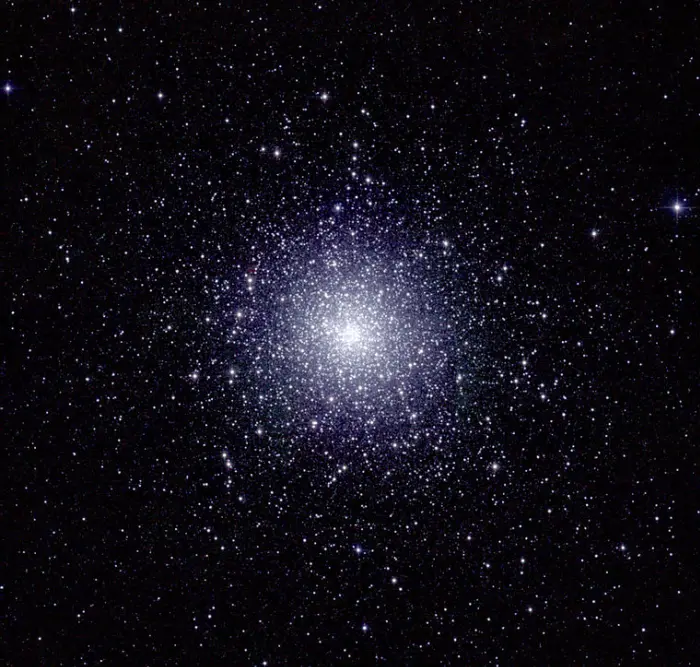
47 Tucanae, image credit: 2MASS/T. Jarrett